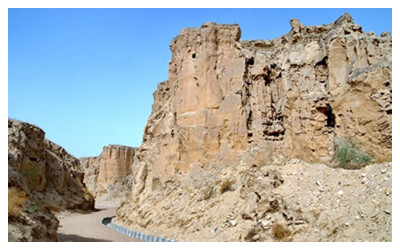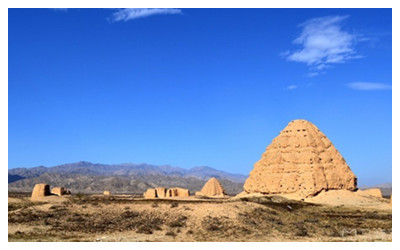- Home
- Province Guide > Ningxia >
Ningxia History
With steeped in history, Ningxia, like a region as culturally rich as the entire area south of the Yangtze River, continues to be admired for its resplendent cultural heritage garnered from the long river of history. During the time of the Tang and Han Dynasties (206 BC - 907 AD) Ningxia was the main place for trade and transportation between the eastern and western regions of ancient China. Ruins of the Great Wall of the Ming Dynasty can be found in its east region.

The stone ware, bone ware and traces of the usage of fire unearthed in the cultural relics of the Paleolithic Age in
Shuidong Gauge of Lingwu City show that there were human beings living in Ningxia back to about 30 thousand years from now. They created what was called “
Shuidong Gauge culture” of late Paleolithic Age.
In 221 BC, after the Qin Dynasty annexed the six states and set up central regime, Ningxia belonged to Beidi County.
During the Tang Dynasty, there were ten “daos” (administrative divisions at that time) in the whole country, and Ningxia belonged to Guannei Dao. The Tang government established Dadudu (governor of the province) Government Office and Shuofang (which means North) Jiedushi (governor of one or more provinces in charge of both civil and military affairs during Tang Dynasty) in Lingzhou (now southwest of Lingwu City). During the Anshi Uprising of the Tang Dynasty, Suzong Emperor of the Tang Dynasty ascended the throng in Lingwu in the year 756 AD.

In 1038 AD, Li Yuanhao, leader of the Dangxiang Tribe, set up Great Xia Kingdom with Ningxia being the center of it. The title of a reigning dynasty is Great Xia (As it was situated to the west of the kingdom of the Song Dynasty, it was historically called Western Xia). Xingqing (now Yinchuan City) was chosen as the capital. It is said that the dynasty in the east reached the Yellow River, in the west bordered on the Yumen, in the south adjoined the Xiao Pass, and in the north faced the great desert, taking up 20,000 li. Thus at that time, the whole country was divided into three dependant Kingdoms: Song, Liao, and Jin.
Ningxia got it name from the Western Xia. In 1227 AD, after the Yuan Dynasty got control over Western Xia, the authorities changed its name to “Ningxia”, which means the pacification and stabilization of Western Xia, and peaceful Western Xia.
In Qing Dynasty, Ningxia Administrative Office was established in this place which gradually became the biggest inhabited area of Hui ethnic group after Emperor Qianlong of the Qing Dynasty.
The name of Ningxia was changed into Shuofang Prefecture in the early years of the Republic of China and replaced by Ningxia Province in 1929 when its area included today’s cities and counties except those in Guyuan Area as well as Alashan Left Banner, Alashan Right Banner, Ejina Banner and Dengkou County which nowadays belong to Inner
Mongolia Autonomous Region.
On September, 23, 1949, Ningxia was liberated without changing the name and the governing area. On October, 25, 1958, Ningxia
Hui Autonomous Region was proclaimed, administering Yinchuan District, Wuzhong
Hui Autonomous Prefecture, Xi(ji)-Hai(yuan)-Gu(yuan) Hui Autonomous Prefecture and two counties—
Jingyuan and Longde.
 The stone ware, bone ware and traces of the usage of fire unearthed in the cultural relics of the Paleolithic Age in Shuidong Gauge of Lingwu City show that there were human beings living in Ningxia back to about 30 thousand years from now. They created what was called “Shuidong Gauge culture” of late Paleolithic Age.
The stone ware, bone ware and traces of the usage of fire unearthed in the cultural relics of the Paleolithic Age in Shuidong Gauge of Lingwu City show that there were human beings living in Ningxia back to about 30 thousand years from now. They created what was called “Shuidong Gauge culture” of late Paleolithic Age. In 1038 AD, Li Yuanhao, leader of the Dangxiang Tribe, set up Great Xia Kingdom with Ningxia being the center of it. The title of a reigning dynasty is Great Xia (As it was situated to the west of the kingdom of the Song Dynasty, it was historically called Western Xia). Xingqing (now Yinchuan City) was chosen as the capital. It is said that the dynasty in the east reached the Yellow River, in the west bordered on the Yumen, in the south adjoined the Xiao Pass, and in the north faced the great desert, taking up 20,000 li. Thus at that time, the whole country was divided into three dependant Kingdoms: Song, Liao, and Jin.
In 1038 AD, Li Yuanhao, leader of the Dangxiang Tribe, set up Great Xia Kingdom with Ningxia being the center of it. The title of a reigning dynasty is Great Xia (As it was situated to the west of the kingdom of the Song Dynasty, it was historically called Western Xia). Xingqing (now Yinchuan City) was chosen as the capital. It is said that the dynasty in the east reached the Yellow River, in the west bordered on the Yumen, in the south adjoined the Xiao Pass, and in the north faced the great desert, taking up 20,000 li. Thus at that time, the whole country was divided into three dependant Kingdoms: Song, Liao, and Jin. Ask Questions ?
Ask Questions ?